ICCR: Workplace Environment and Leadership Analysis Report
VerifiedAdded on 2022/10/01
|10
|2956
|6
Report
AI Summary
This report examines the workplace environment at the Independent Center for Clinical Researcher (ICCR), a pharmaceutical company founded by Rachel Adams. Initially successful under her charismatic leadership, the company faced challenges as Adams's leadership style evolved, leading to a decline in employee engagement and strategic planning. The report analyzes the impact of her shift towards Laissez-Faire leadership and the lack of democratic and strategic approaches. It explores the need for improved strategic planning, open communication, and the implementation of strategic leadership principles, including distributive responsibility, transparency, and embracing innovation. The analysis highlights the importance of adapting leadership styles to maintain a positive and productive workplace environment, emphasizing the need for leaders to foster collaboration, accept failures, and provide opportunities for employee engagement to drive organizational success. The report suggests various leadership styles that Rachel could have followed in order to improve the performance and declining status of the organization, which includes democratic, strategic and transformational leadership.
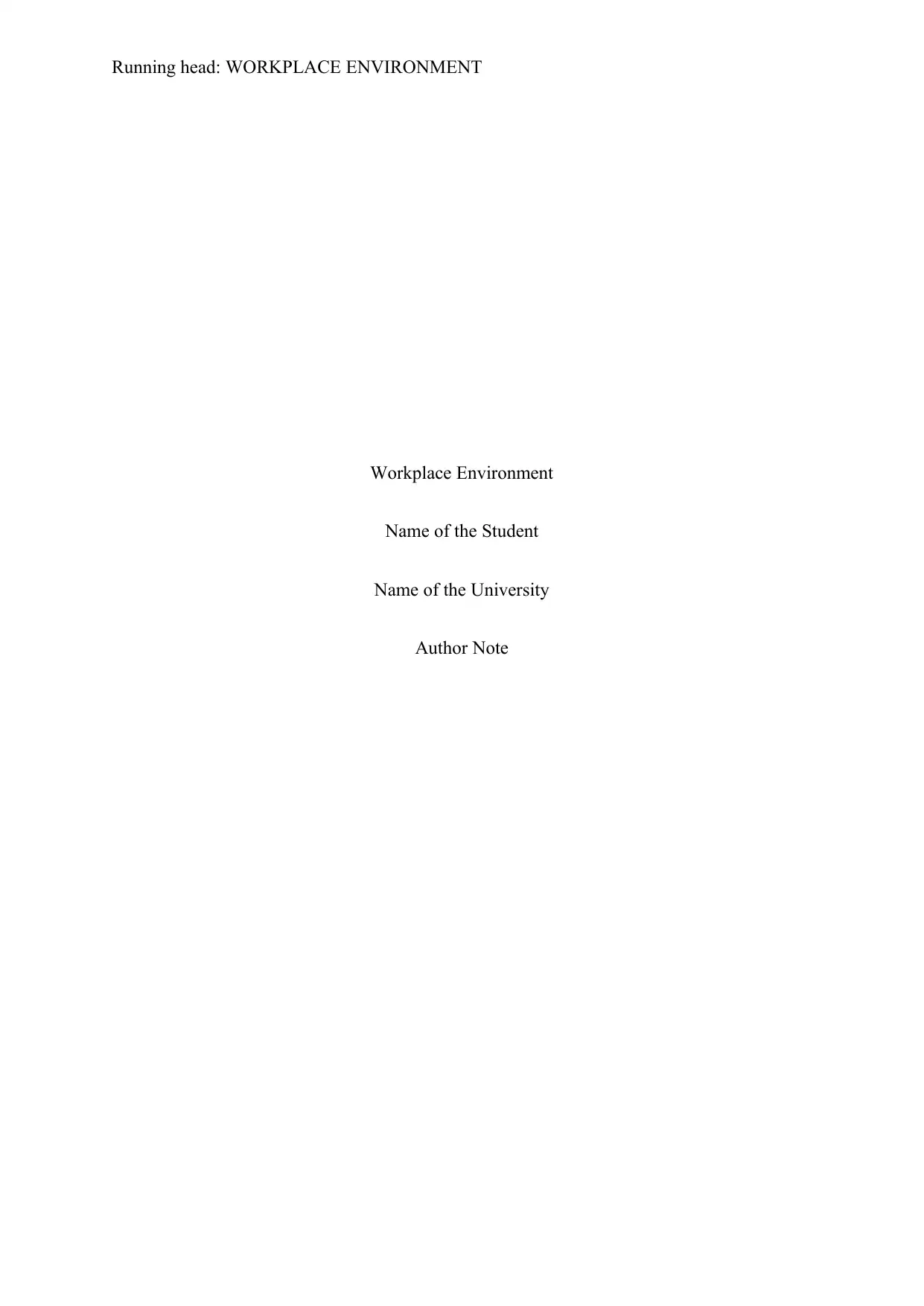
Running head: WORKPLACE ENVIRONMENT
Workplace Environment
Name of the Student
Name of the University
Author Note
Workplace Environment
Name of the Student
Name of the University
Author Note
Paraphrase This Document
Need a fresh take? Get an instant paraphrase of this document with our AI Paraphraser
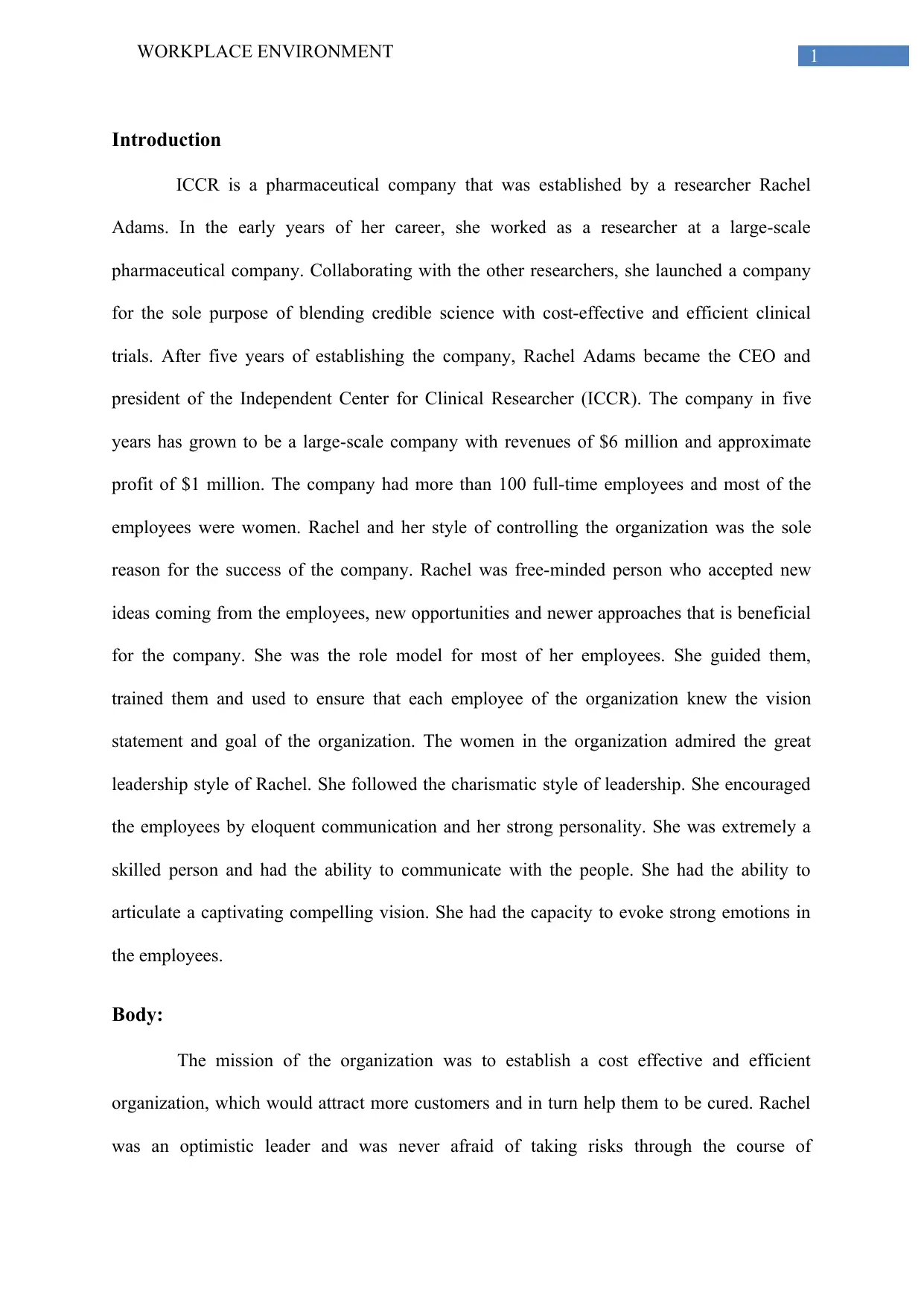
1WORKPLACE ENVIRONMENT
Introduction
ICCR is a pharmaceutical company that was established by a researcher Rachel
Adams. In the early years of her career, she worked as a researcher at a large-scale
pharmaceutical company. Collaborating with the other researchers, she launched a company
for the sole purpose of blending credible science with cost-effective and efficient clinical
trials. After five years of establishing the company, Rachel Adams became the CEO and
president of the Independent Center for Clinical Researcher (ICCR). The company in five
years has grown to be a large-scale company with revenues of $6 million and approximate
profit of $1 million. The company had more than 100 full-time employees and most of the
employees were women. Rachel and her style of controlling the organization was the sole
reason for the success of the company. Rachel was free-minded person who accepted new
ideas coming from the employees, new opportunities and newer approaches that is beneficial
for the company. She was the role model for most of her employees. She guided them,
trained them and used to ensure that each employee of the organization knew the vision
statement and goal of the organization. The women in the organization admired the great
leadership style of Rachel. She followed the charismatic style of leadership. She encouraged
the employees by eloquent communication and her strong personality. She was extremely a
skilled person and had the ability to communicate with the people. She had the ability to
articulate a captivating compelling vision. She had the capacity to evoke strong emotions in
the employees.
Body:
The mission of the organization was to establish a cost effective and efficient
organization, which would attract more customers and in turn help them to be cured. Rachel
was an optimistic leader and was never afraid of taking risks through the course of
Introduction
ICCR is a pharmaceutical company that was established by a researcher Rachel
Adams. In the early years of her career, she worked as a researcher at a large-scale
pharmaceutical company. Collaborating with the other researchers, she launched a company
for the sole purpose of blending credible science with cost-effective and efficient clinical
trials. After five years of establishing the company, Rachel Adams became the CEO and
president of the Independent Center for Clinical Researcher (ICCR). The company in five
years has grown to be a large-scale company with revenues of $6 million and approximate
profit of $1 million. The company had more than 100 full-time employees and most of the
employees were women. Rachel and her style of controlling the organization was the sole
reason for the success of the company. Rachel was free-minded person who accepted new
ideas coming from the employees, new opportunities and newer approaches that is beneficial
for the company. She was the role model for most of her employees. She guided them,
trained them and used to ensure that each employee of the organization knew the vision
statement and goal of the organization. The women in the organization admired the great
leadership style of Rachel. She followed the charismatic style of leadership. She encouraged
the employees by eloquent communication and her strong personality. She was extremely a
skilled person and had the ability to communicate with the people. She had the ability to
articulate a captivating compelling vision. She had the capacity to evoke strong emotions in
the employees.
Body:
The mission of the organization was to establish a cost effective and efficient
organization, which would attract more customers and in turn help them to be cured. Rachel
was an optimistic leader and was never afraid of taking risks through the course of
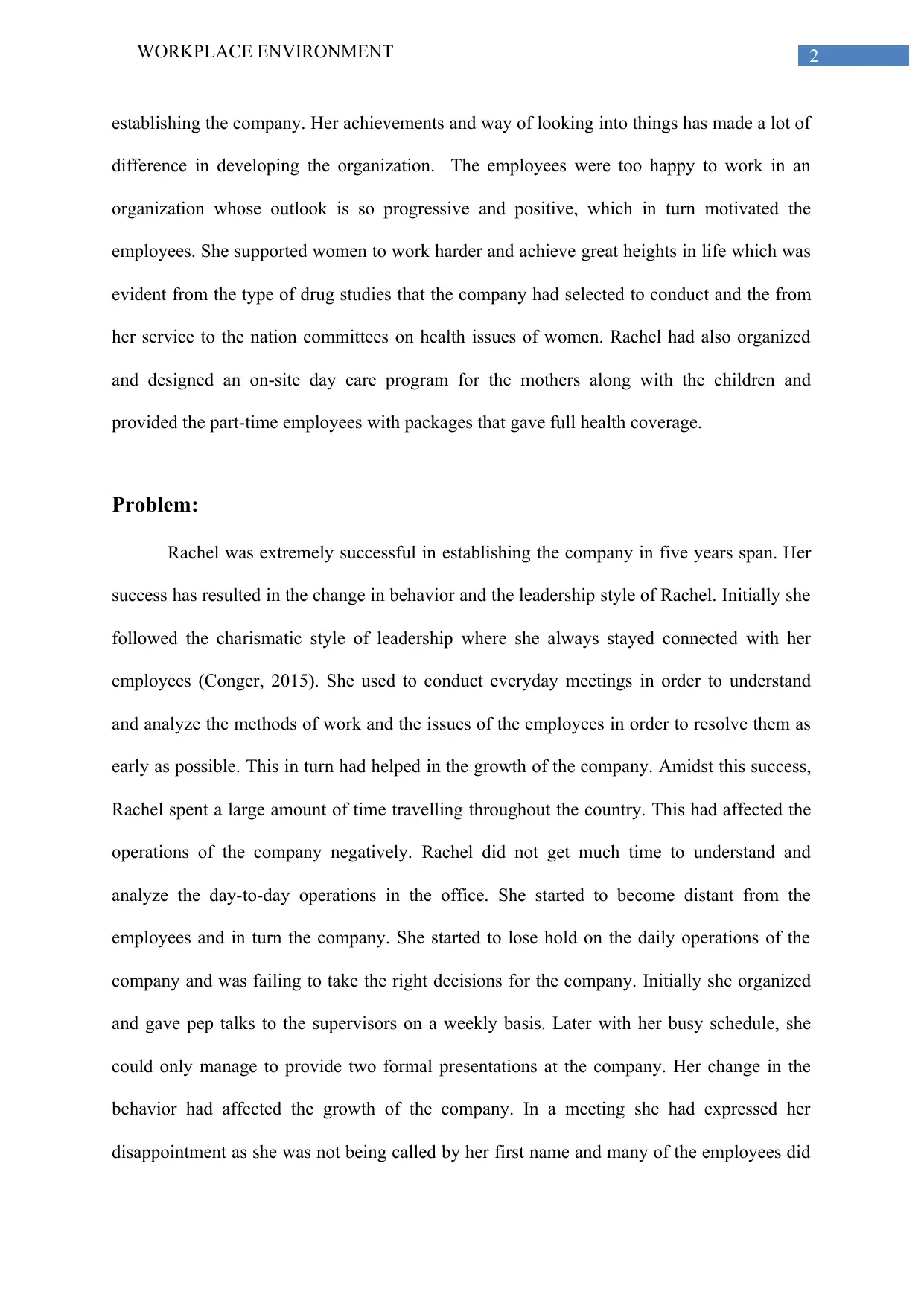
2WORKPLACE ENVIRONMENT
establishing the company. Her achievements and way of looking into things has made a lot of
difference in developing the organization. The employees were too happy to work in an
organization whose outlook is so progressive and positive, which in turn motivated the
employees. She supported women to work harder and achieve great heights in life which was
evident from the type of drug studies that the company had selected to conduct and the from
her service to the nation committees on health issues of women. Rachel had also organized
and designed an on-site day care program for the mothers along with the children and
provided the part-time employees with packages that gave full health coverage.
Problem:
Rachel was extremely successful in establishing the company in five years span. Her
success has resulted in the change in behavior and the leadership style of Rachel. Initially she
followed the charismatic style of leadership where she always stayed connected with her
employees (Conger, 2015). She used to conduct everyday meetings in order to understand
and analyze the methods of work and the issues of the employees in order to resolve them as
early as possible. This in turn had helped in the growth of the company. Amidst this success,
Rachel spent a large amount of time travelling throughout the country. This had affected the
operations of the company negatively. Rachel did not get much time to understand and
analyze the day-to-day operations in the office. She started to become distant from the
employees and in turn the company. She started to lose hold on the daily operations of the
company and was failing to take the right decisions for the company. Initially she organized
and gave pep talks to the supervisors on a weekly basis. Later with her busy schedule, she
could only manage to provide two formal presentations at the company. Her change in the
behavior had affected the growth of the company. In a meeting she had expressed her
disappointment as she was not being called by her first name and many of the employees did
establishing the company. Her achievements and way of looking into things has made a lot of
difference in developing the organization. The employees were too happy to work in an
organization whose outlook is so progressive and positive, which in turn motivated the
employees. She supported women to work harder and achieve great heights in life which was
evident from the type of drug studies that the company had selected to conduct and the from
her service to the nation committees on health issues of women. Rachel had also organized
and designed an on-site day care program for the mothers along with the children and
provided the part-time employees with packages that gave full health coverage.
Problem:
Rachel was extremely successful in establishing the company in five years span. Her
success has resulted in the change in behavior and the leadership style of Rachel. Initially she
followed the charismatic style of leadership where she always stayed connected with her
employees (Conger, 2015). She used to conduct everyday meetings in order to understand
and analyze the methods of work and the issues of the employees in order to resolve them as
early as possible. This in turn had helped in the growth of the company. Amidst this success,
Rachel spent a large amount of time travelling throughout the country. This had affected the
operations of the company negatively. Rachel did not get much time to understand and
analyze the day-to-day operations in the office. She started to become distant from the
employees and in turn the company. She started to lose hold on the daily operations of the
company and was failing to take the right decisions for the company. Initially she organized
and gave pep talks to the supervisors on a weekly basis. Later with her busy schedule, she
could only manage to provide two formal presentations at the company. Her change in the
behavior had affected the growth of the company. In a meeting she had expressed her
disappointment as she was not being called by her first name and many of the employees did
⊘ This is a preview!⊘
Do you want full access?
Subscribe today to unlock all pages.

Trusted by 1+ million students worldwide
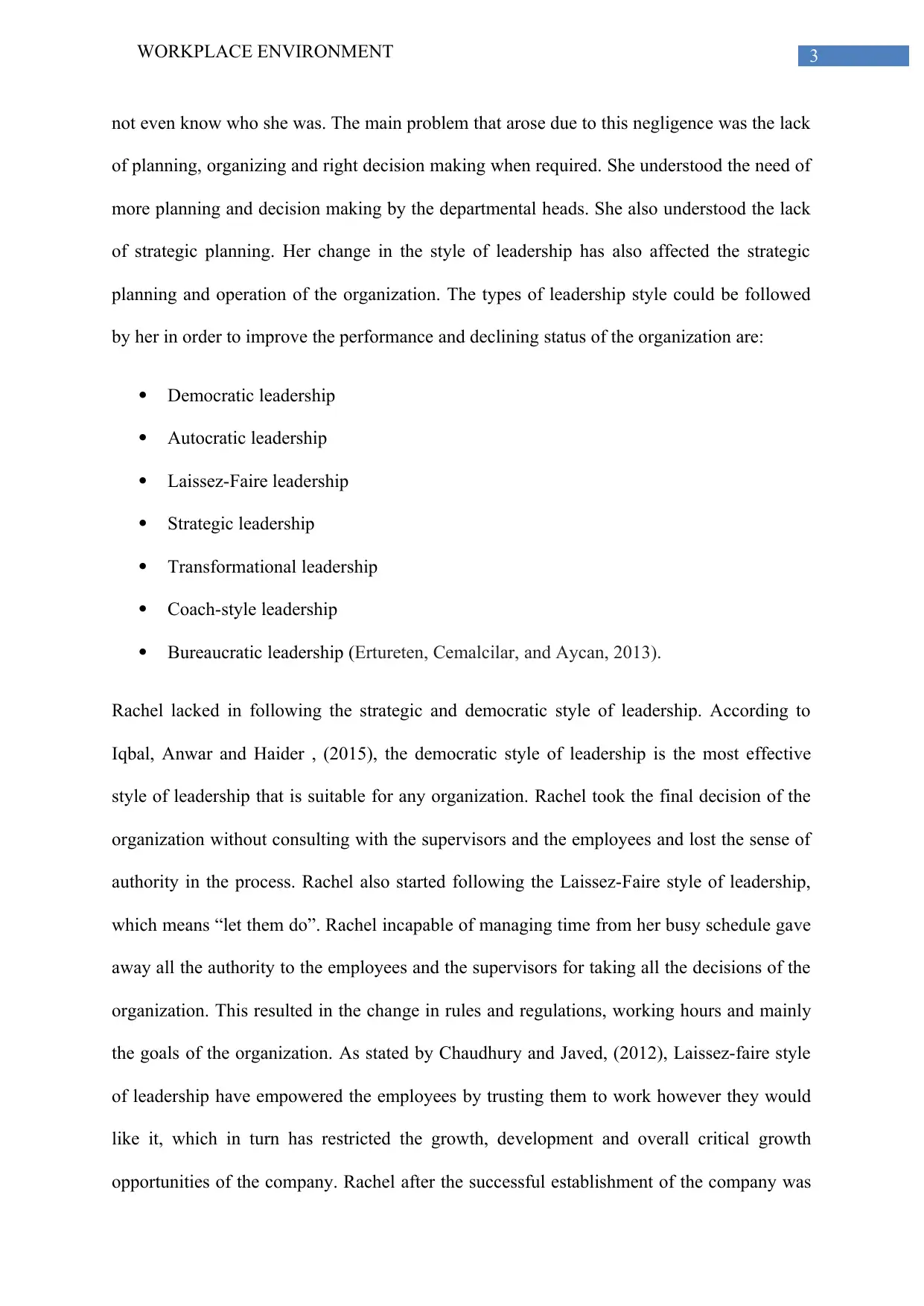
3WORKPLACE ENVIRONMENT
not even know who she was. The main problem that arose due to this negligence was the lack
of planning, organizing and right decision making when required. She understood the need of
more planning and decision making by the departmental heads. She also understood the lack
of strategic planning. Her change in the style of leadership has also affected the strategic
planning and operation of the organization. The types of leadership style could be followed
by her in order to improve the performance and declining status of the organization are:
Democratic leadership
Autocratic leadership
Laissez-Faire leadership
Strategic leadership
Transformational leadership
Coach-style leadership
Bureaucratic leadership (Ertureten, Cemalcilar, and Aycan, 2013).
Rachel lacked in following the strategic and democratic style of leadership. According to
Iqbal, Anwar and Haider , (2015), the democratic style of leadership is the most effective
style of leadership that is suitable for any organization. Rachel took the final decision of the
organization without consulting with the supervisors and the employees and lost the sense of
authority in the process. Rachel also started following the Laissez-Faire style of leadership,
which means “let them do”. Rachel incapable of managing time from her busy schedule gave
away all the authority to the employees and the supervisors for taking all the decisions of the
organization. This resulted in the change in rules and regulations, working hours and mainly
the goals of the organization. As stated by Chaudhury and Javed, (2012), Laissez-faire style
of leadership have empowered the employees by trusting them to work however they would
like it, which in turn has restricted the growth, development and overall critical growth
opportunities of the company. Rachel after the successful establishment of the company was
not even know who she was. The main problem that arose due to this negligence was the lack
of planning, organizing and right decision making when required. She understood the need of
more planning and decision making by the departmental heads. She also understood the lack
of strategic planning. Her change in the style of leadership has also affected the strategic
planning and operation of the organization. The types of leadership style could be followed
by her in order to improve the performance and declining status of the organization are:
Democratic leadership
Autocratic leadership
Laissez-Faire leadership
Strategic leadership
Transformational leadership
Coach-style leadership
Bureaucratic leadership (Ertureten, Cemalcilar, and Aycan, 2013).
Rachel lacked in following the strategic and democratic style of leadership. According to
Iqbal, Anwar and Haider , (2015), the democratic style of leadership is the most effective
style of leadership that is suitable for any organization. Rachel took the final decision of the
organization without consulting with the supervisors and the employees and lost the sense of
authority in the process. Rachel also started following the Laissez-Faire style of leadership,
which means “let them do”. Rachel incapable of managing time from her busy schedule gave
away all the authority to the employees and the supervisors for taking all the decisions of the
organization. This resulted in the change in rules and regulations, working hours and mainly
the goals of the organization. As stated by Chaudhury and Javed, (2012), Laissez-faire style
of leadership have empowered the employees by trusting them to work however they would
like it, which in turn has restricted the growth, development and overall critical growth
opportunities of the company. Rachel after the successful establishment of the company was
Paraphrase This Document
Need a fresh take? Get an instant paraphrase of this document with our AI Paraphraser
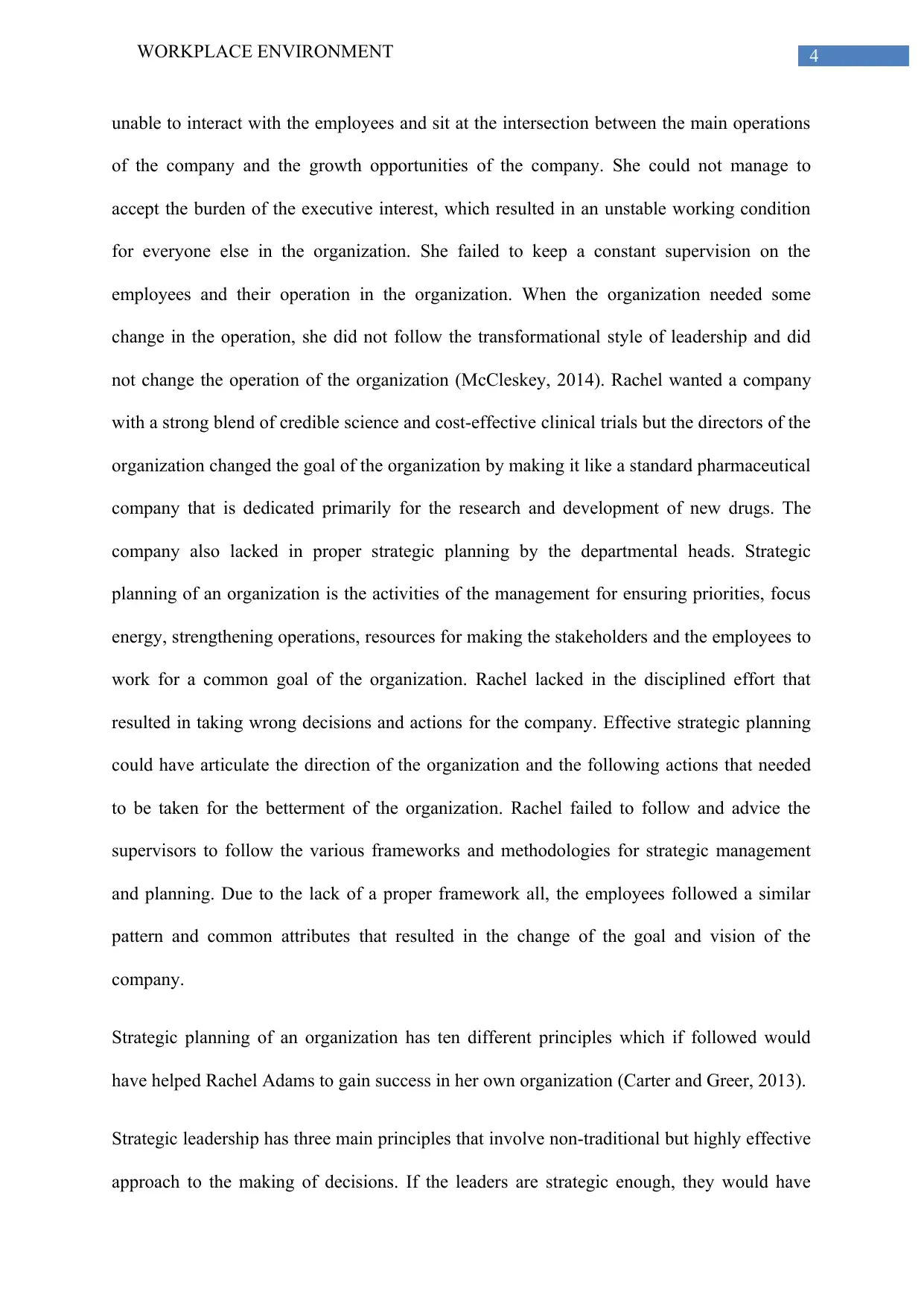
4WORKPLACE ENVIRONMENT
unable to interact with the employees and sit at the intersection between the main operations
of the company and the growth opportunities of the company. She could not manage to
accept the burden of the executive interest, which resulted in an unstable working condition
for everyone else in the organization. She failed to keep a constant supervision on the
employees and their operation in the organization. When the organization needed some
change in the operation, she did not follow the transformational style of leadership and did
not change the operation of the organization (McCleskey, 2014). Rachel wanted a company
with a strong blend of credible science and cost-effective clinical trials but the directors of the
organization changed the goal of the organization by making it like a standard pharmaceutical
company that is dedicated primarily for the research and development of new drugs. The
company also lacked in proper strategic planning by the departmental heads. Strategic
planning of an organization is the activities of the management for ensuring priorities, focus
energy, strengthening operations, resources for making the stakeholders and the employees to
work for a common goal of the organization. Rachel lacked in the disciplined effort that
resulted in taking wrong decisions and actions for the company. Effective strategic planning
could have articulate the direction of the organization and the following actions that needed
to be taken for the betterment of the organization. Rachel failed to follow and advice the
supervisors to follow the various frameworks and methodologies for strategic management
and planning. Due to the lack of a proper framework all, the employees followed a similar
pattern and common attributes that resulted in the change of the goal and vision of the
company.
Strategic planning of an organization has ten different principles which if followed would
have helped Rachel Adams to gain success in her own organization (Carter and Greer, 2013).
Strategic leadership has three main principles that involve non-traditional but highly effective
approach to the making of decisions. If the leaders are strategic enough, they would have
unable to interact with the employees and sit at the intersection between the main operations
of the company and the growth opportunities of the company. She could not manage to
accept the burden of the executive interest, which resulted in an unstable working condition
for everyone else in the organization. She failed to keep a constant supervision on the
employees and their operation in the organization. When the organization needed some
change in the operation, she did not follow the transformational style of leadership and did
not change the operation of the organization (McCleskey, 2014). Rachel wanted a company
with a strong blend of credible science and cost-effective clinical trials but the directors of the
organization changed the goal of the organization by making it like a standard pharmaceutical
company that is dedicated primarily for the research and development of new drugs. The
company also lacked in proper strategic planning by the departmental heads. Strategic
planning of an organization is the activities of the management for ensuring priorities, focus
energy, strengthening operations, resources for making the stakeholders and the employees to
work for a common goal of the organization. Rachel lacked in the disciplined effort that
resulted in taking wrong decisions and actions for the company. Effective strategic planning
could have articulate the direction of the organization and the following actions that needed
to be taken for the betterment of the organization. Rachel failed to follow and advice the
supervisors to follow the various frameworks and methodologies for strategic management
and planning. Due to the lack of a proper framework all, the employees followed a similar
pattern and common attributes that resulted in the change of the goal and vision of the
company.
Strategic planning of an organization has ten different principles which if followed would
have helped Rachel Adams to gain success in her own organization (Carter and Greer, 2013).
Strategic leadership has three main principles that involve non-traditional but highly effective
approach to the making of decisions. If the leaders are strategic enough, they would have
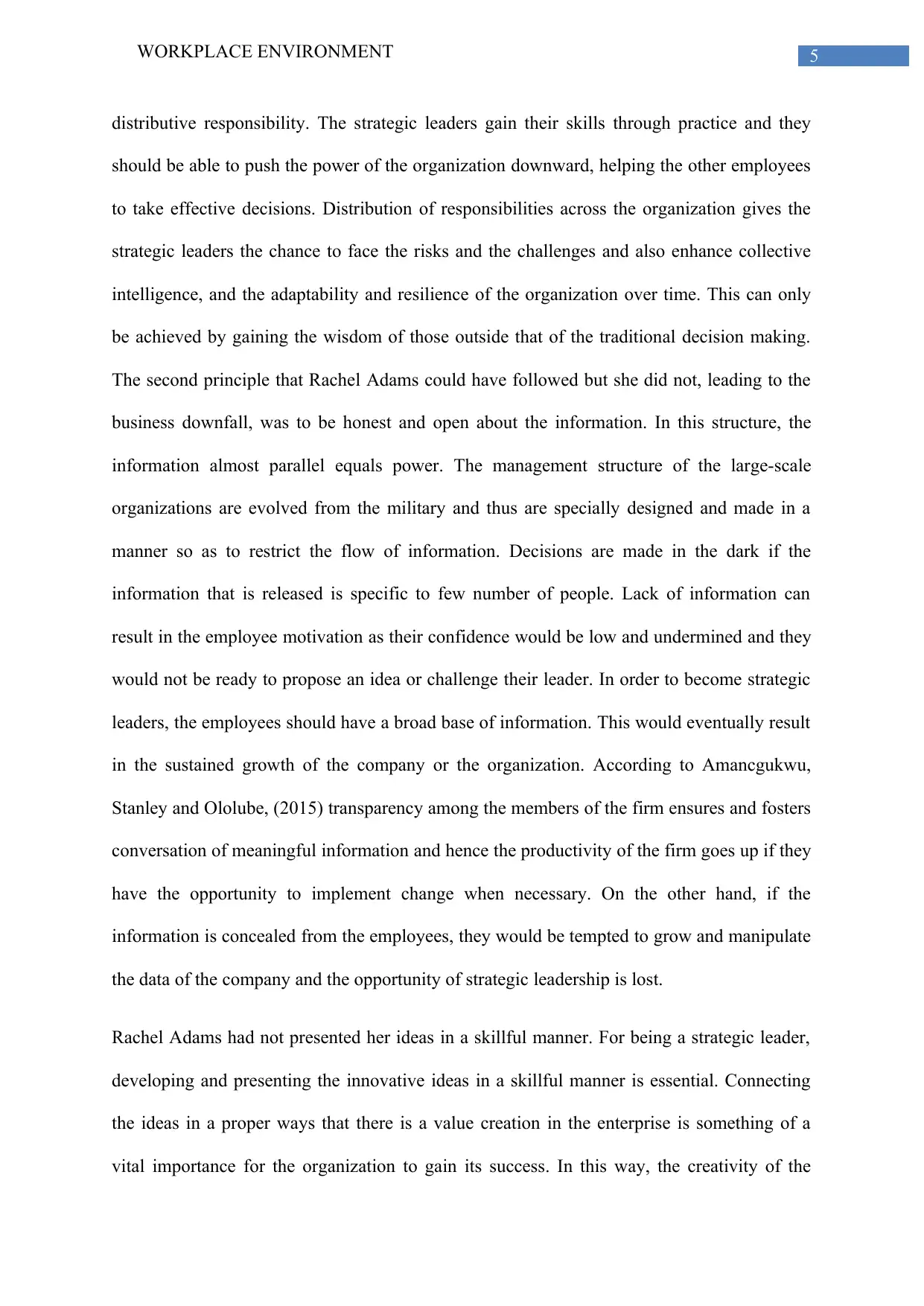
5WORKPLACE ENVIRONMENT
distributive responsibility. The strategic leaders gain their skills through practice and they
should be able to push the power of the organization downward, helping the other employees
to take effective decisions. Distribution of responsibilities across the organization gives the
strategic leaders the chance to face the risks and the challenges and also enhance collective
intelligence, and the adaptability and resilience of the organization over time. This can only
be achieved by gaining the wisdom of those outside that of the traditional decision making.
The second principle that Rachel Adams could have followed but she did not, leading to the
business downfall, was to be honest and open about the information. In this structure, the
information almost parallel equals power. The management structure of the large-scale
organizations are evolved from the military and thus are specially designed and made in a
manner so as to restrict the flow of information. Decisions are made in the dark if the
information that is released is specific to few number of people. Lack of information can
result in the employee motivation as their confidence would be low and undermined and they
would not be ready to propose an idea or challenge their leader. In order to become strategic
leaders, the employees should have a broad base of information. This would eventually result
in the sustained growth of the company or the organization. According to Amancgukwu,
Stanley and Ololube, (2015) transparency among the members of the firm ensures and fosters
conversation of meaningful information and hence the productivity of the firm goes up if they
have the opportunity to implement change when necessary. On the other hand, if the
information is concealed from the employees, they would be tempted to grow and manipulate
the data of the company and the opportunity of strategic leadership is lost.
Rachel Adams had not presented her ideas in a skillful manner. For being a strategic leader,
developing and presenting the innovative ideas in a skillful manner is essential. Connecting
the ideas in a proper ways that there is a value creation in the enterprise is something of a
vital importance for the organization to gain its success. In this way, the creativity of the
distributive responsibility. The strategic leaders gain their skills through practice and they
should be able to push the power of the organization downward, helping the other employees
to take effective decisions. Distribution of responsibilities across the organization gives the
strategic leaders the chance to face the risks and the challenges and also enhance collective
intelligence, and the adaptability and resilience of the organization over time. This can only
be achieved by gaining the wisdom of those outside that of the traditional decision making.
The second principle that Rachel Adams could have followed but she did not, leading to the
business downfall, was to be honest and open about the information. In this structure, the
information almost parallel equals power. The management structure of the large-scale
organizations are evolved from the military and thus are specially designed and made in a
manner so as to restrict the flow of information. Decisions are made in the dark if the
information that is released is specific to few number of people. Lack of information can
result in the employee motivation as their confidence would be low and undermined and they
would not be ready to propose an idea or challenge their leader. In order to become strategic
leaders, the employees should have a broad base of information. This would eventually result
in the sustained growth of the company or the organization. According to Amancgukwu,
Stanley and Ololube, (2015) transparency among the members of the firm ensures and fosters
conversation of meaningful information and hence the productivity of the firm goes up if they
have the opportunity to implement change when necessary. On the other hand, if the
information is concealed from the employees, they would be tempted to grow and manipulate
the data of the company and the opportunity of strategic leadership is lost.
Rachel Adams had not presented her ideas in a skillful manner. For being a strategic leader,
developing and presenting the innovative ideas in a skillful manner is essential. Connecting
the ideas in a proper ways that there is a value creation in the enterprise is something of a
vital importance for the organization to gain its success. In this way, the creativity of the
⊘ This is a preview!⊘
Do you want full access?
Subscribe today to unlock all pages.

Trusted by 1+ million students worldwide
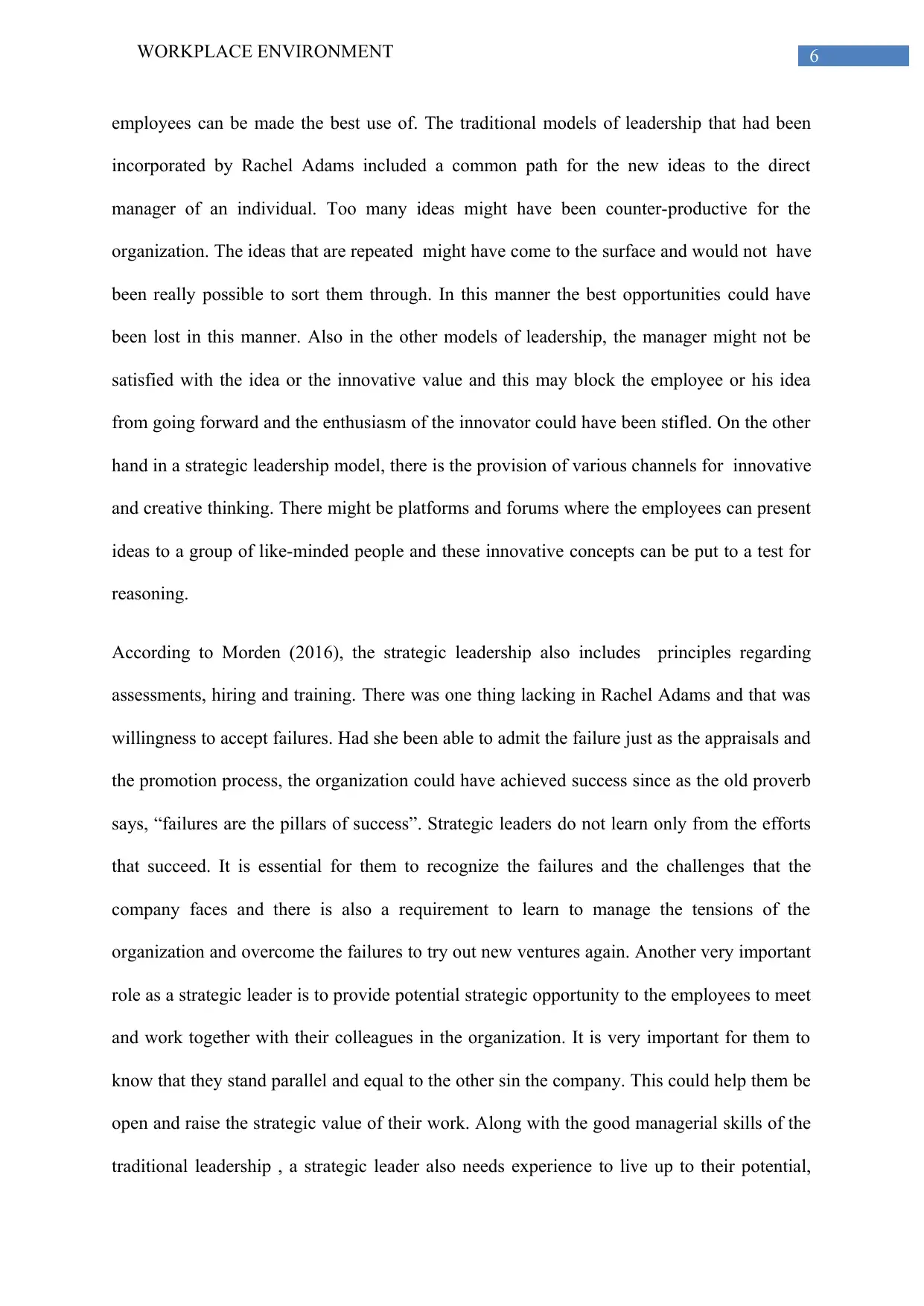
6WORKPLACE ENVIRONMENT
employees can be made the best use of. The traditional models of leadership that had been
incorporated by Rachel Adams included a common path for the new ideas to the direct
manager of an individual. Too many ideas might have been counter-productive for the
organization. The ideas that are repeated might have come to the surface and would not have
been really possible to sort them through. In this manner the best opportunities could have
been lost in this manner. Also in the other models of leadership, the manager might not be
satisfied with the idea or the innovative value and this may block the employee or his idea
from going forward and the enthusiasm of the innovator could have been stifled. On the other
hand in a strategic leadership model, there is the provision of various channels for innovative
and creative thinking. There might be platforms and forums where the employees can present
ideas to a group of like-minded people and these innovative concepts can be put to a test for
reasoning.
According to Morden (2016), the strategic leadership also includes principles regarding
assessments, hiring and training. There was one thing lacking in Rachel Adams and that was
willingness to accept failures. Had she been able to admit the failure just as the appraisals and
the promotion process, the organization could have achieved success since as the old proverb
says, “failures are the pillars of success”. Strategic leaders do not learn only from the efforts
that succeed. It is essential for them to recognize the failures and the challenges that the
company faces and there is also a requirement to learn to manage the tensions of the
organization and overcome the failures to try out new ventures again. Another very important
role as a strategic leader is to provide potential strategic opportunity to the employees to meet
and work together with their colleagues in the organization. It is very important for them to
know that they stand parallel and equal to the other sin the company. This could help them be
open and raise the strategic value of their work. Along with the good managerial skills of the
traditional leadership , a strategic leader also needs experience to live up to their potential,
employees can be made the best use of. The traditional models of leadership that had been
incorporated by Rachel Adams included a common path for the new ideas to the direct
manager of an individual. Too many ideas might have been counter-productive for the
organization. The ideas that are repeated might have come to the surface and would not have
been really possible to sort them through. In this manner the best opportunities could have
been lost in this manner. Also in the other models of leadership, the manager might not be
satisfied with the idea or the innovative value and this may block the employee or his idea
from going forward and the enthusiasm of the innovator could have been stifled. On the other
hand in a strategic leadership model, there is the provision of various channels for innovative
and creative thinking. There might be platforms and forums where the employees can present
ideas to a group of like-minded people and these innovative concepts can be put to a test for
reasoning.
According to Morden (2016), the strategic leadership also includes principles regarding
assessments, hiring and training. There was one thing lacking in Rachel Adams and that was
willingness to accept failures. Had she been able to admit the failure just as the appraisals and
the promotion process, the organization could have achieved success since as the old proverb
says, “failures are the pillars of success”. Strategic leaders do not learn only from the efforts
that succeed. It is essential for them to recognize the failures and the challenges that the
company faces and there is also a requirement to learn to manage the tensions of the
organization and overcome the failures to try out new ventures again. Another very important
role as a strategic leader is to provide potential strategic opportunity to the employees to meet
and work together with their colleagues in the organization. It is very important for them to
know that they stand parallel and equal to the other sin the company. This could help them be
open and raise the strategic value of their work. Along with the good managerial skills of the
traditional leadership , a strategic leader also needs experience to live up to their potential,
Paraphrase This Document
Need a fresh take? Get an instant paraphrase of this document with our AI Paraphraser
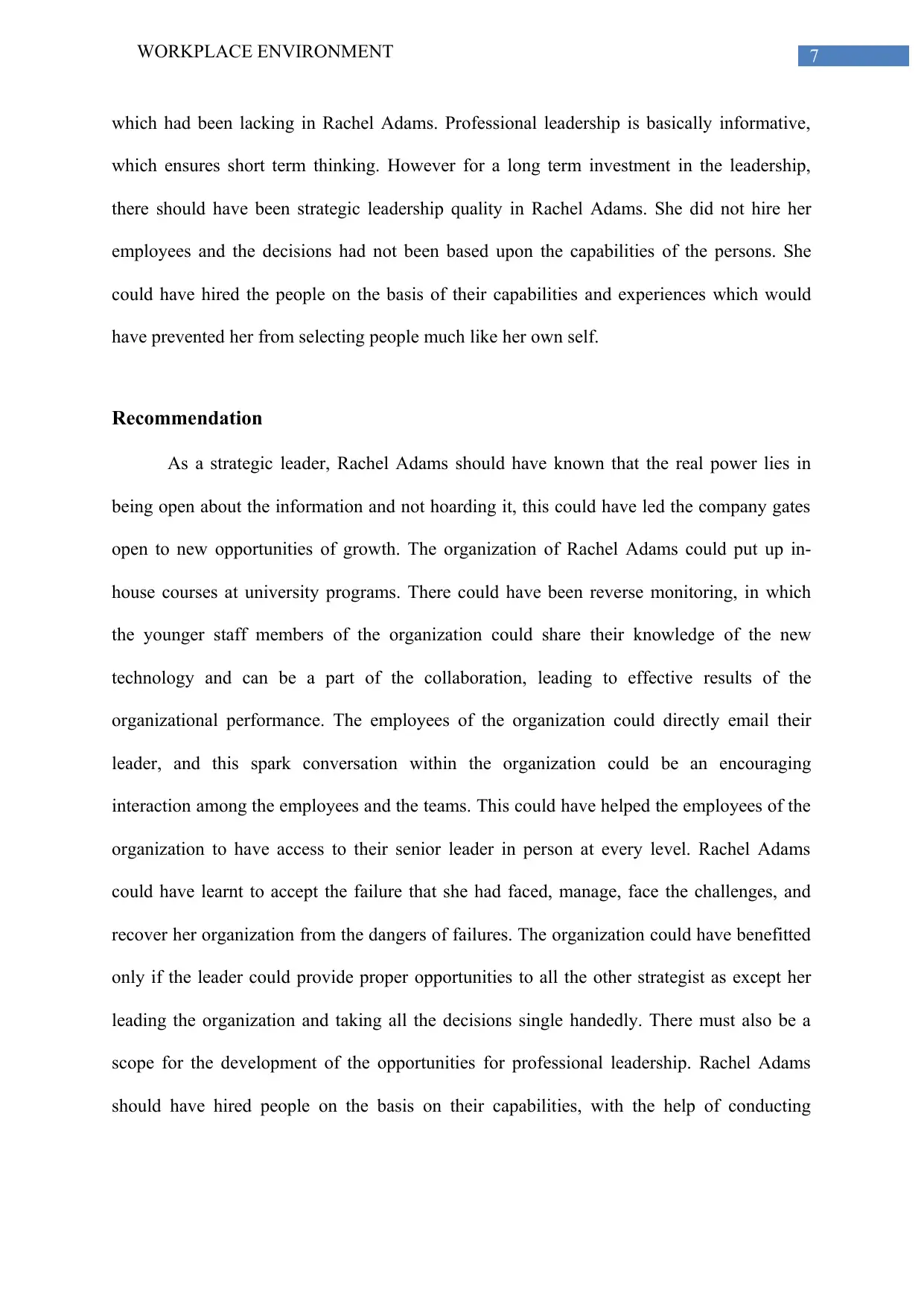
7WORKPLACE ENVIRONMENT
which had been lacking in Rachel Adams. Professional leadership is basically informative,
which ensures short term thinking. However for a long term investment in the leadership,
there should have been strategic leadership quality in Rachel Adams. She did not hire her
employees and the decisions had not been based upon the capabilities of the persons. She
could have hired the people on the basis of their capabilities and experiences which would
have prevented her from selecting people much like her own self.
Recommendation
As a strategic leader, Rachel Adams should have known that the real power lies in
being open about the information and not hoarding it, this could have led the company gates
open to new opportunities of growth. The organization of Rachel Adams could put up in-
house courses at university programs. There could have been reverse monitoring, in which
the younger staff members of the organization could share their knowledge of the new
technology and can be a part of the collaboration, leading to effective results of the
organizational performance. The employees of the organization could directly email their
leader, and this spark conversation within the organization could be an encouraging
interaction among the employees and the teams. This could have helped the employees of the
organization to have access to their senior leader in person at every level. Rachel Adams
could have learnt to accept the failure that she had faced, manage, face the challenges, and
recover her organization from the dangers of failures. The organization could have benefitted
only if the leader could provide proper opportunities to all the other strategist as except her
leading the organization and taking all the decisions single handedly. There must also be a
scope for the development of the opportunities for professional leadership. Rachel Adams
should have hired people on the basis on their capabilities, with the help of conducting
which had been lacking in Rachel Adams. Professional leadership is basically informative,
which ensures short term thinking. However for a long term investment in the leadership,
there should have been strategic leadership quality in Rachel Adams. She did not hire her
employees and the decisions had not been based upon the capabilities of the persons. She
could have hired the people on the basis of their capabilities and experiences which would
have prevented her from selecting people much like her own self.
Recommendation
As a strategic leader, Rachel Adams should have known that the real power lies in
being open about the information and not hoarding it, this could have led the company gates
open to new opportunities of growth. The organization of Rachel Adams could put up in-
house courses at university programs. There could have been reverse monitoring, in which
the younger staff members of the organization could share their knowledge of the new
technology and can be a part of the collaboration, leading to effective results of the
organizational performance. The employees of the organization could directly email their
leader, and this spark conversation within the organization could be an encouraging
interaction among the employees and the teams. This could have helped the employees of the
organization to have access to their senior leader in person at every level. Rachel Adams
could have learnt to accept the failure that she had faced, manage, face the challenges, and
recover her organization from the dangers of failures. The organization could have benefitted
only if the leader could provide proper opportunities to all the other strategist as except her
leading the organization and taking all the decisions single handedly. There must also be a
scope for the development of the opportunities for professional leadership. Rachel Adams
should have hired people on the basis on their capabilities, with the help of conducting
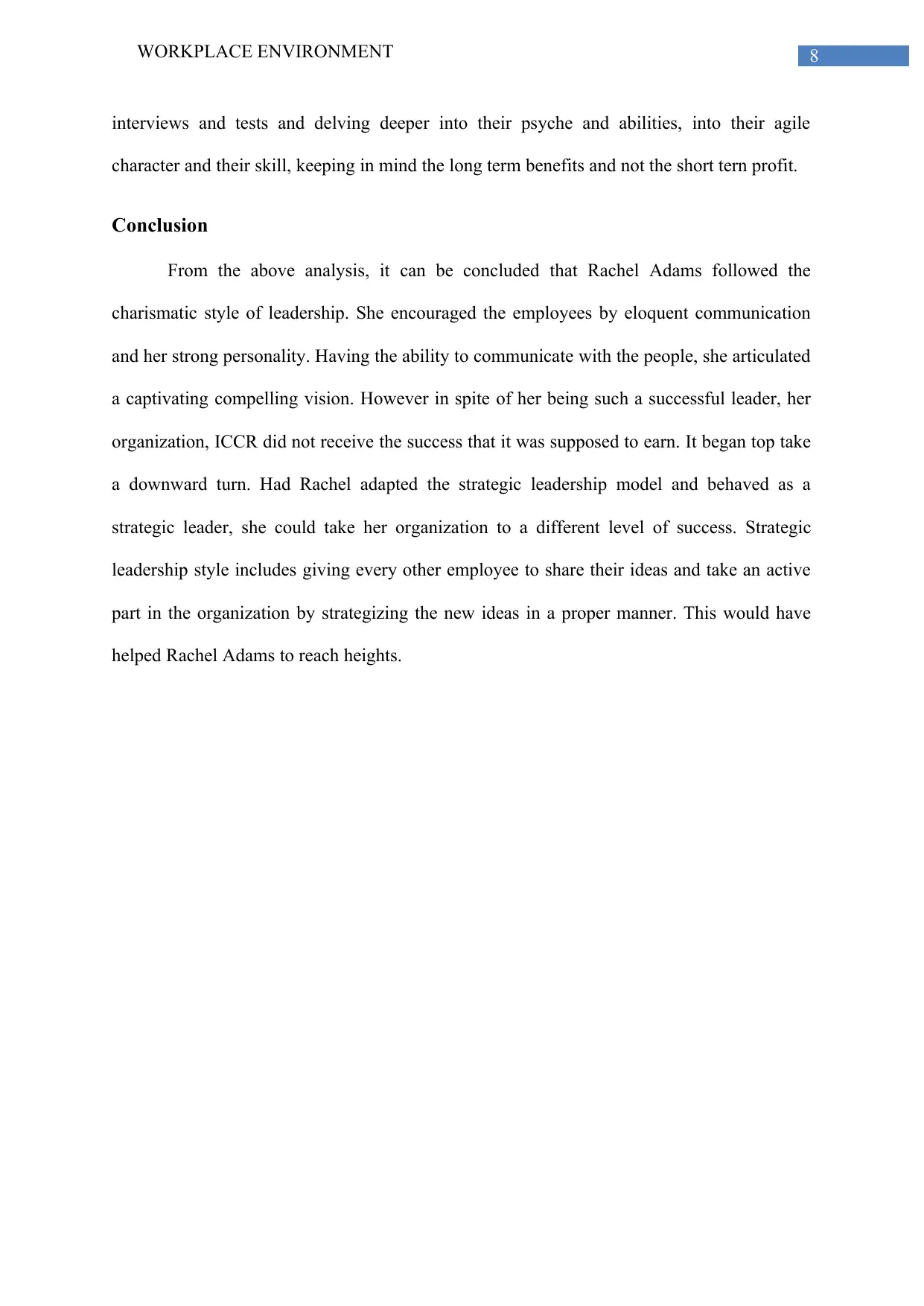
8WORKPLACE ENVIRONMENT
interviews and tests and delving deeper into their psyche and abilities, into their agile
character and their skill, keeping in mind the long term benefits and not the short tern profit.
Conclusion
From the above analysis, it can be concluded that Rachel Adams followed the
charismatic style of leadership. She encouraged the employees by eloquent communication
and her strong personality. Having the ability to communicate with the people, she articulated
a captivating compelling vision. However in spite of her being such a successful leader, her
organization, ICCR did not receive the success that it was supposed to earn. It began top take
a downward turn. Had Rachel adapted the strategic leadership model and behaved as a
strategic leader, she could take her organization to a different level of success. Strategic
leadership style includes giving every other employee to share their ideas and take an active
part in the organization by strategizing the new ideas in a proper manner. This would have
helped Rachel Adams to reach heights.
interviews and tests and delving deeper into their psyche and abilities, into their agile
character and their skill, keeping in mind the long term benefits and not the short tern profit.
Conclusion
From the above analysis, it can be concluded that Rachel Adams followed the
charismatic style of leadership. She encouraged the employees by eloquent communication
and her strong personality. Having the ability to communicate with the people, she articulated
a captivating compelling vision. However in spite of her being such a successful leader, her
organization, ICCR did not receive the success that it was supposed to earn. It began top take
a downward turn. Had Rachel adapted the strategic leadership model and behaved as a
strategic leader, she could take her organization to a different level of success. Strategic
leadership style includes giving every other employee to share their ideas and take an active
part in the organization by strategizing the new ideas in a proper manner. This would have
helped Rachel Adams to reach heights.
⊘ This is a preview!⊘
Do you want full access?
Subscribe today to unlock all pages.

Trusted by 1+ million students worldwide
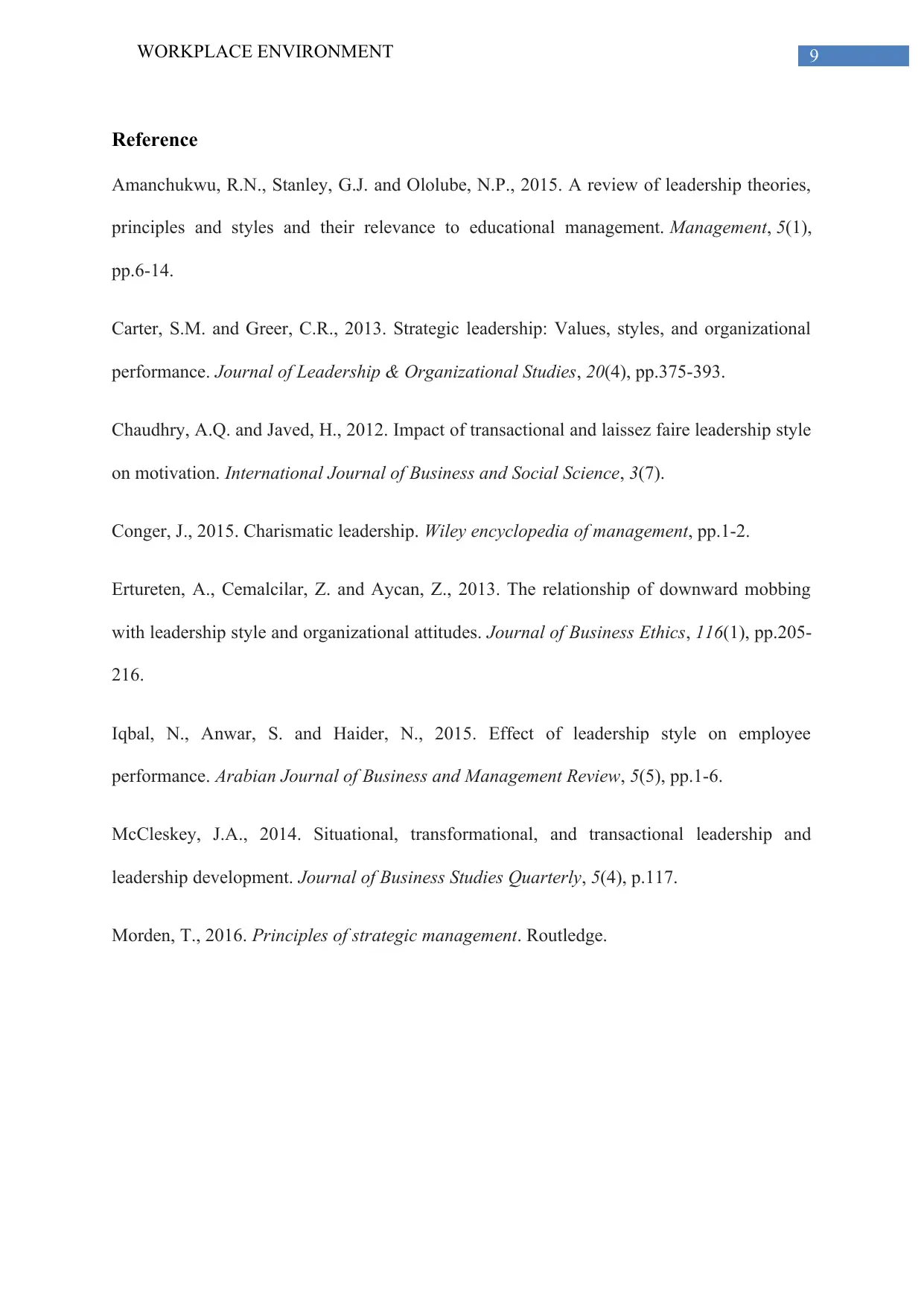
9WORKPLACE ENVIRONMENT
Reference
Amanchukwu, R.N., Stanley, G.J. and Ololube, N.P., 2015. A review of leadership theories,
principles and styles and their relevance to educational management. Management, 5(1),
pp.6-14.
Carter, S.M. and Greer, C.R., 2013. Strategic leadership: Values, styles, and organizational
performance. Journal of Leadership & Organizational Studies, 20(4), pp.375-393.
Chaudhry, A.Q. and Javed, H., 2012. Impact of transactional and laissez faire leadership style
on motivation. International Journal of Business and Social Science, 3(7).
Conger, J., 2015. Charismatic leadership. Wiley encyclopedia of management, pp.1-2.
Ertureten, A., Cemalcilar, Z. and Aycan, Z., 2013. The relationship of downward mobbing
with leadership style and organizational attitudes. Journal of Business Ethics, 116(1), pp.205-
216.
Iqbal, N., Anwar, S. and Haider, N., 2015. Effect of leadership style on employee
performance. Arabian Journal of Business and Management Review, 5(5), pp.1-6.
McCleskey, J.A., 2014. Situational, transformational, and transactional leadership and
leadership development. Journal of Business Studies Quarterly, 5(4), p.117.
Morden, T., 2016. Principles of strategic management. Routledge.
Reference
Amanchukwu, R.N., Stanley, G.J. and Ololube, N.P., 2015. A review of leadership theories,
principles and styles and their relevance to educational management. Management, 5(1),
pp.6-14.
Carter, S.M. and Greer, C.R., 2013. Strategic leadership: Values, styles, and organizational
performance. Journal of Leadership & Organizational Studies, 20(4), pp.375-393.
Chaudhry, A.Q. and Javed, H., 2012. Impact of transactional and laissez faire leadership style
on motivation. International Journal of Business and Social Science, 3(7).
Conger, J., 2015. Charismatic leadership. Wiley encyclopedia of management, pp.1-2.
Ertureten, A., Cemalcilar, Z. and Aycan, Z., 2013. The relationship of downward mobbing
with leadership style and organizational attitudes. Journal of Business Ethics, 116(1), pp.205-
216.
Iqbal, N., Anwar, S. and Haider, N., 2015. Effect of leadership style on employee
performance. Arabian Journal of Business and Management Review, 5(5), pp.1-6.
McCleskey, J.A., 2014. Situational, transformational, and transactional leadership and
leadership development. Journal of Business Studies Quarterly, 5(4), p.117.
Morden, T., 2016. Principles of strategic management. Routledge.
1 out of 10
Related Documents
Your All-in-One AI-Powered Toolkit for Academic Success.
+13062052269
info@desklib.com
Available 24*7 on WhatsApp / Email
![[object Object]](/_next/static/media/star-bottom.7253800d.svg)
Unlock your academic potential
Copyright © 2020–2025 A2Z Services. All Rights Reserved. Developed and managed by ZUCOL.



